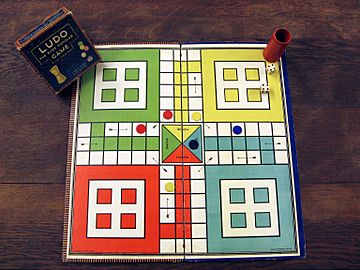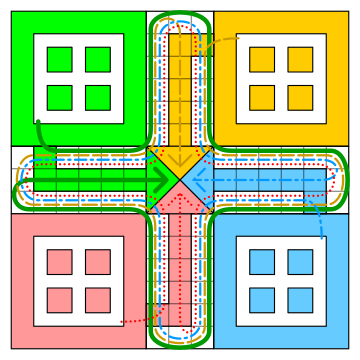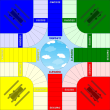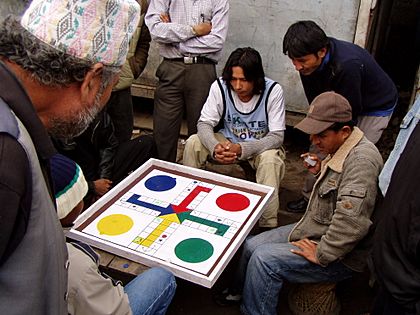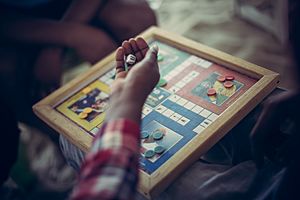Ludo (board game) facts for kids
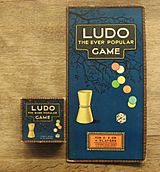
One of the first editions of Ludo
|
|
| Years active | Since c. 1896 |
|---|---|
| Genre(s) | Board game Race game Dice game |
| Players | 2–4 |
| Playing time | < 90 min |
| Random chance | High (dice rolling) |
| Skill(s) required | Strategy, tactics, counting, probability |
Ludo ( from Latin ludo, meaning 'I play') is a strategy board game for two to four players, in which the players race their four tokens from start to finish according to the rolls of a single die. Like other cross and circle games, Ludo is derived from the Indian game Pachisi, but simpler. The game and its variations are popular in many countries and under various names.
Contents
Ludo board
Special areas of the Ludo board are typically coloured bright yellow, green, red, and blue. Each player is assigned a colour and has four tokens in their colour. The board is normally square with a cross-shaped playspace, with each arm of the cross having three columns of squares, usually six per column. The middle columns usually have five squares coloured; these represent a player's home column. A sixth coloured square not on the home column is a player's starting square. At the centre of the board is a large finishing square, often composed of coloured triangles atop the players' home columns (thus depicting "arrows" pointing to the finish).
Rules
Overview
Two, three, or four can play, without partnerships. At the beginning of the game, each player's four tokens are out of play and staged in the player's yard (one of the large corner areas of the board in the player's colour). When able to, the players will enter their tokens one per turn on their respective starting squares, and proceed to race them clockwise around the board along the game track (the path of squares not part of any player's home column). When reaching the square below his home column, a player continues by moving tokens up the column to the finishing square. The rolls of a single die control the swiftness of the tokens, and entry to the finishing square requires a precise roll from the player. The first to bring all their tokens to the finish wins the game. The others often continue to play to determine second-, third-, and fourth-place finishers.
Gameplay
Each player rolls the die; the highest roller begins the game. Players alternate turns in a clockwise direction.
To enter a token into play from its yard to its starting square, a player must roll a 6. The player can draw a token from home every time he gets a 6 unless home is empty or move a piece 6 times. The start box has 2 own tokens (is doubled). If the player has no tokens yet in play and rolls other than a 6, the turn passes to the next player.
Players must always move a token according to the die value rolled. Once a player has one or more tokens in play, he selects a token and moves it forwards along the track the number of squares indicated by the die. If an opponent's token is blocking your pathway, you will need to land on the same space as the token to capture it. You cannot move past that token. Passes are not allowed; if no move is possible, the turn moves to the next player.
If the player cannot draw a token from home, rolling a 6 earns the player an additional or "bonus" roll in that turn. If the bonus roll results in a 6 again, the player earns again an additional bonus roll. If the third roll is also a 6, the player may not move and the turn immediately passes to the next player.
If the advance of a token ends on a square occupied by an opponent's token, the opponent token is returned to its owner's yard. The returned token can be reentered into play only when the owner rolls a 6. If a piece lands on the same space as another piece of the same colour, the pieces are doubled and form a "block". If the advance of a block ends on an opponent’s block, the latter is captured and returned to its owner’s yard, collectively.
A player's home column squares are always safe since no opponent may enter them. In the home column, you cannot jump over your token. Roll the exact number needed to get each token onto the home triangle.
Variants
list of international variants
Ludo exists under different names, brands and various game derivations:
- Uckers, British
- Pachisi, Indian
- Fia, Swedish
- Eile mit Weile (Haste makes Pace), Swiss
- Cờ cá ngựa, Vietnamese
Spanish & Colombian
- Parchís, Spanish
- Parqués, Colombian
- Vuelta obligada (mandatory restart)
- Cielo robado (stolen heaven)
- De piedra en piedra (from stone to stone)
- Con Policía (With Policeman)
Mensch ärgere dich nicht
Mensch ärgere dich nicht (Mate, Don't Get Angry), is a German game from 1914 and has equivalent names in Bulgarian, Croatian, Slovenian, Serbian, Macedonian, Albanian, Greek, Romanian, Turkish, Czech, and Slovak.
- Mens Erger Je Niet, Dutch
- Non t'arrabiare, Italian
German specific
- Verliere nicht den Kopf (Do not lose your head)
- Coppit
French
- Petits Chevaux (Little Cavalry)
- Jeu des petits chevaux
Hasbro
Hasbro has multiple brand names for ludo-like games from its acquisitions including:
- Aggravation
- Headache
- Game of Headaches, British
- Based on Pachisi
- Parcheesi, North American
- Sorry!; North American and British
- Trouble, North American
- Kimble, Finnish version of trouble
- Frustration, British and Irish version of trouble
Chinese
- Aeroplane chess: A Chinese cross-and-circle board game derived from Ludo, using aeroplanes as tokens, with additional features such as colored cells, jumps and shortcuts.
Differences
- Ludo played in the Indian subcontinent features a safe square in each quadrant, normally the fourth square from the top in the rightmost column. These squares are usually marked with a star. In India Ludo is often played with two dice, and rolling 1 on a die also allows a token to enter active play. Thus if a player rolls a 1 and a 6, they may get a token out and move it six steps.
- In Pakistan, a variation that uses two dice allows backwards movement. The dice are rolled and the die values can be used independently or in combination to move two pieces or a single piece forwards or backwards or both. (E.g., if the roll gives 1 and 4, the player can move a single piece 4 steps forwards and then 1 step backwards, or 1 step forwards and 4 steps backwards, or 1 then 4 steps forwards or backwards. Or the player can move a piece 1 step forwards or backwards, and another piece 4 steps forwards or backwards.)
- To get a game started faster, some house rules allow a player with no pieces on the board to bring their first piece into play on any roll, on a 1 or a 6, or allow multiple tries to roll a 6 (with three rolls being the most popular).
- If a piece lands on the same space as another piece of the same colour, the moved piece must take the preceding space.
- Some variations permit doubled blocks to be passed by rolling a 6 or 1.
- A block of two or more pieces can be taken by an opponent's single piece.
- Doubled pieces may move half the number if an even number is thrown (e.g. move two spaces if a 4 is thrown).
- A doubled piece may capture another doubled piece (like in Coppit). Three pieces together are weak and can be cut by a single piece.
- A board may have only four spaces in each home column. All four of a player's pieces must finish in these spaces for the player to have finished the game. (See Mensch ärgere dich nicht.)
- A player must move all the numbers rolled (e.g. if a player rolls multiple 6s, they have to use all the numbers to move).
- A player cannot capture or enter finish if they have numbers remaining. (E.g., if a player rolls a 6 and a 2 and they have the option to capture or enter finish with one of their pieces using the 2, they can only do so if they have another piece that can use the 6.)
- To speed the game up, extra turns or bonus moves can be awarded for capturing a piece or getting a piece home; these may grant passage past a block.
- In Denmark and some other countries the board has eight spaces marked with a globe and eight with a star. The globes are safe spaces where a piece cannot be captured. The exception is that a player who has not yet entered all pieces, can always enter a piece on a roll of 6. If the entry space is occupied by another player's piece, that piece is captured. Otherwise the entry spaces work like the other globe spaces. A piece which would have landed on a star instead moves to the next star.
- In Vietnam, it is called "Cờ cá ngựa", where the game is modeled after a horse race with the tokens modeled as horse heads. In this variation, a 1 is given equal status to a 6 (meaning that the player can enter a token into play and can roll again). Furthermore, once a player's token reaches their home column, it can only go up each square with an exact roll. This means that a person outside the column must roll a 1 to enter the first square, a 2 afterwards to enter the second, and so forth.
African
In some parts of Africa the following rules are reportedly played:
- A doubled block also blocks trailing pieces of the player who created the block, or blocks them unless they roll the exact number to land on the block; additionally, the doubled block cannot move forwards until the block that landed upon it moves off again. This reduces the tactical advantage of a block and makes the game more interesting.
- If the two players sitting opposite are partners, the players can exchange numbers.
- There are four safety squares on the board, like castle squares in Pachisi, as well as the safe home squares, where a piece may able to move forwards or backwards and start their turn before previous player finishes.
- A piece landing on a square with an opponent's piece not only sends the opponent piece back to the starting area but also sends the landing piece to its home square.
- A player cannot move their first piece into the home column unless they have captured at least one piece of any of the opponents.
- If a player captures the piece of another player, they are awarded a bonus roll. If in the bonus roll, another player's piece is captured, another bonus roll is awarded and so on.
See also
 In Spanish: Ludo para niños
In Spanish: Ludo para niños


